Your garden should be an oasis. You can start off by planting some beautiful, fragrant, and colorful flowers to brighten your mood. You can even opt for a soft grass that feels amazing between your toes or even a fountain for a bit of a luxurious touch! However, the beauty of your backyard is not really complete without the birds that grace your garden. In particular, one of the most popular birds to attract to any yard is the cardinal.
But how do you attract these cardinals to your yard in the first place? Let’s go over the 12 ways to attract cardinals to your yard to really complete the paradisical look of your backyard.
Cardinals
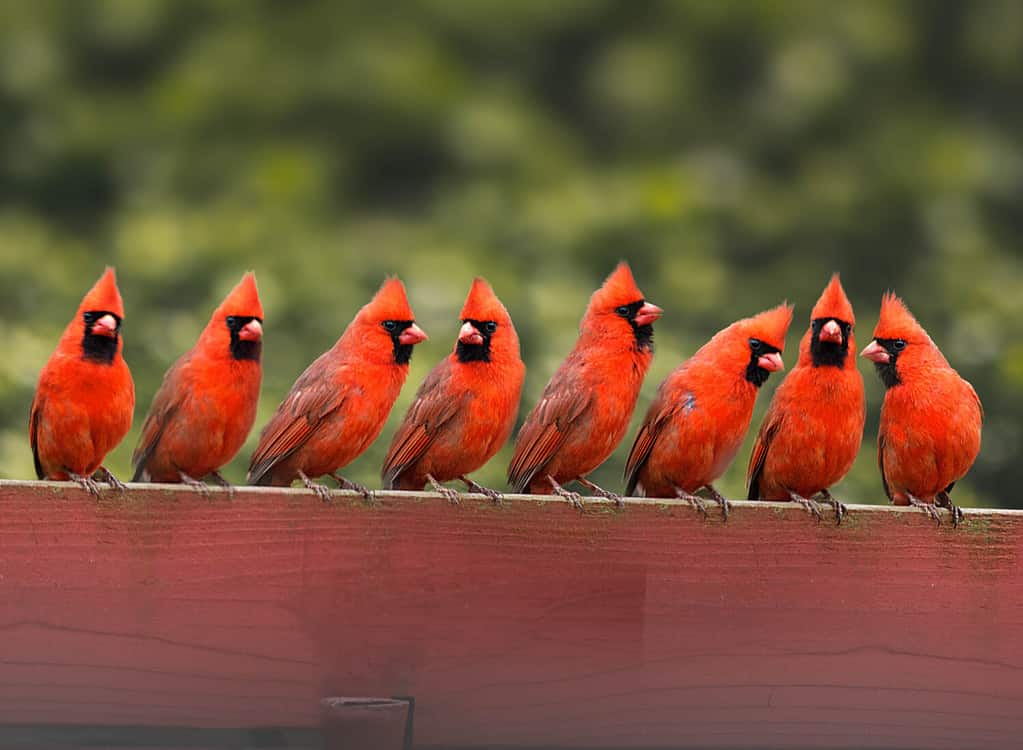
Cardinals are beautiful bright red birds that can be found in North and Central America.
©Rizwan Mian/Shutterstock.com
Firstly, before we jump in. What are cardinals?
You probably already are pretty familiar with cardinals or, specifically, northern cardinals, as they’re one of the most striking birds in North America. A songbird from the bunting family, the cardinal is native to North America and is found from southeastern Canada through eastern and central USA to Mexico, Belize, and even as far south as Guatemala.
There are an estimated 120 million cardinals throughout North and Central America, and these birds can be found in a variety of habitats. They have a preference for woodland edges, shrublands, thickets, and, of course, suburban gardens, too!
Northern cardinals symbolize beauty and grace and are known for their stunning, colorful appearance. Their vivid colors and melodic songs make them a favorite among bird enthusiasts. Cardinals are sexually dichromatic, meaning the males and females have differing coloration. Males have that signature firetruck red coloring all over, with a reddish bill and a black face around the bill. Females, on the other hand, are pale brown in color with reddish tinges in the tail, wings, and crest.
In terms of size, cardinals grow to around 7 to 9 inches long with a wingspan of 10 to 12 inches.
Cardinals are omnivores and enjoy eating insects like flies, ants, true bugs, grasshoppers, and beetles. They also love eating fruit, nectar, sap, and seeds.
Why Attract Cardinals to Your Yard?
So, why should you go the extra mile to entice cardinals into your yard? Of course, their red coat adds beauty to your garden, so you can bring your friends and family over to watch these birds flutter about your yard! Birdwatching is a way to connect you to nature, offering more than just aesthetic appeal.
Cardinals are also known for their melodious songs. Their clear, whistling tunes can provide a soothing and enjoyable soundtrack to your outdoor space, making your garden all the more relaxing!
Furthermore, encouraging cardinals to visit your yard can contribute to the overall biodiversity of your local ecosystem. Attracting a variety of bird species can help maintain a healthy balance of wildlife in your area.
And finally, if you have a garden in your backyard, attracting any kind of bird, including cardinals, can be a huge advantage. As omnivorous birds, cardinals feed on a variety of insects and seeds. By attracting cardinals to your yard, you can help control insect populations naturally, reducing the need for chemical pesticides.
So, now that you know the many various reasons why you would want cardinals in your yard, let’s jump into the 12 different methods to attract them!
1. Provide Thick Habitat

Dogwood is a favorite among cardinals.
©LapaiIrKrapai/Shutterstock.com
Cardinals are friendly birds, but they treasure their privacy, too. Planting thick, dense bushes and shrubs is a good way to provide them with an ideal habitat. Native plants like dogwood, holly, and viburnum are excellent choices. Interestingly, cardinals do not migrate, so evergreen plants like pine, spruce, or cedar trees can also be a good option for cardinals. Whatever you decide to plant in your garden, simply make sure the cardinals have plenty of space to perch and sing.
2. Provide Proper Nutrition

Cardinals enjoy a varied diet, with some of their favorite foods being cracked corn (pictured), crushed peanuts, and berries.
©Garsya/iStock via Getty Images
Cardinals appreciate a well-stocked pantry, and having readily available and nutritious food will make your yard all the more enticing! Offering them a variety of nutritious foods will make your yard irresistible. Have feeders throughout your yard, and make sure to keep them full.
Some of their favorite foods include large seeds, crushed peanuts, berries, and cracked corn. Suet is another great choice as well – especially in the winter. Cardinals are not very picky, so a wide range of seeds and fruits can make for an attractive feast.
3. Provide Cardinal-Friendly Feeders
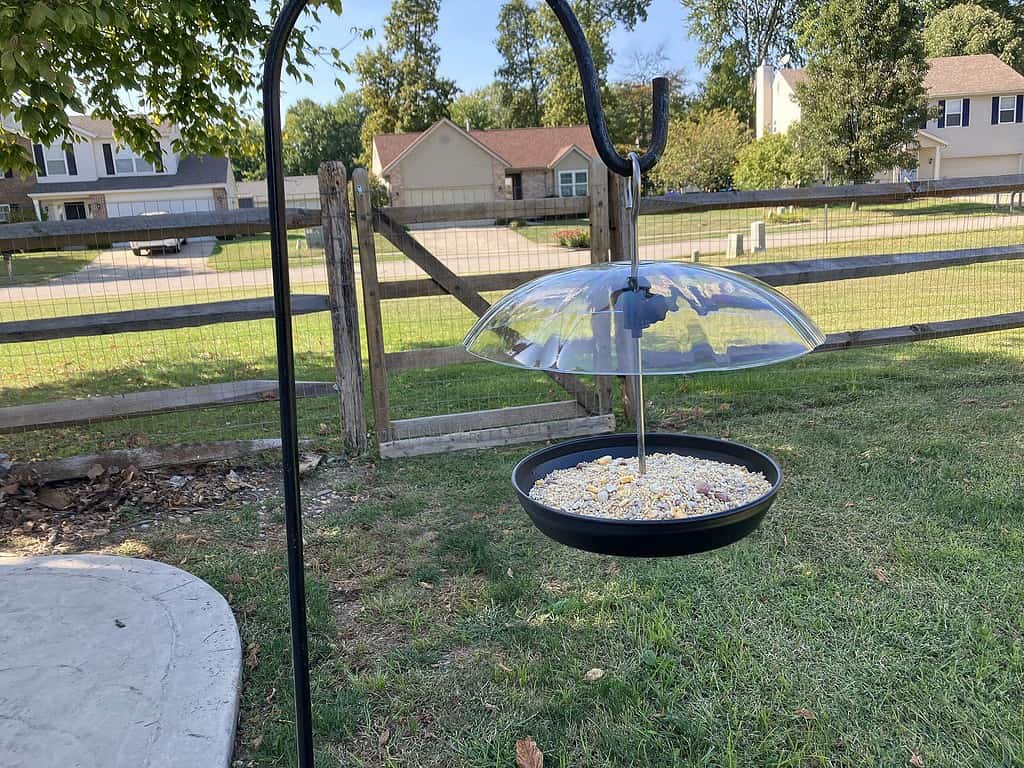
Cardinals do not like enclosed and tiny bird feeders; they prefer platform feeders like the one pictured above.
Cardinals prefer platform feeders or tray feeders. These provide a flat surface that allows them to perch comfortably while feeding. And since cardinals are not exactly tiny birds, they may also appreciate spacious feeders that accommodate their size. Look for feeders with ample space for them to feed without feeling crowded.
Opt for feeders with an open design that allows cardinals to easily spot their food. This also helps them feel more secure while feeding. Cardinals are nervous by nature, so enclosed feeders are not the best option.
4. Refill Birdfeeders Promptly
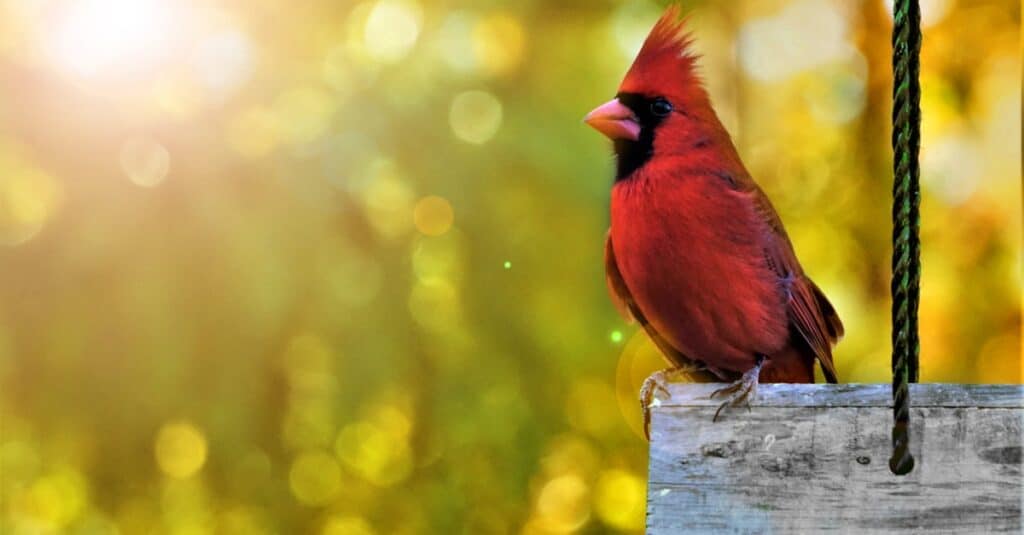
If your bird feeder is slowly dwindling, make sure to top it up!
©iStock.com/ANCHASA MITCHELL
Like many birds, cardinals love a reliable food source, and an empty feeder may discourage them from returning. Consider using larger feeders that can hold more seed to minimize the frequency of refills.
Also, take appropriate measures to safeguard the birdfeeders from squirrels and other pesky critters. Invest in squirrel-resistant feeders or use baffles and other deterrents to keep these furry pests at bay. This ensures that cardinals and other birds have plenty of food to keep them around your backyard.
5. Keep Clean Feeders
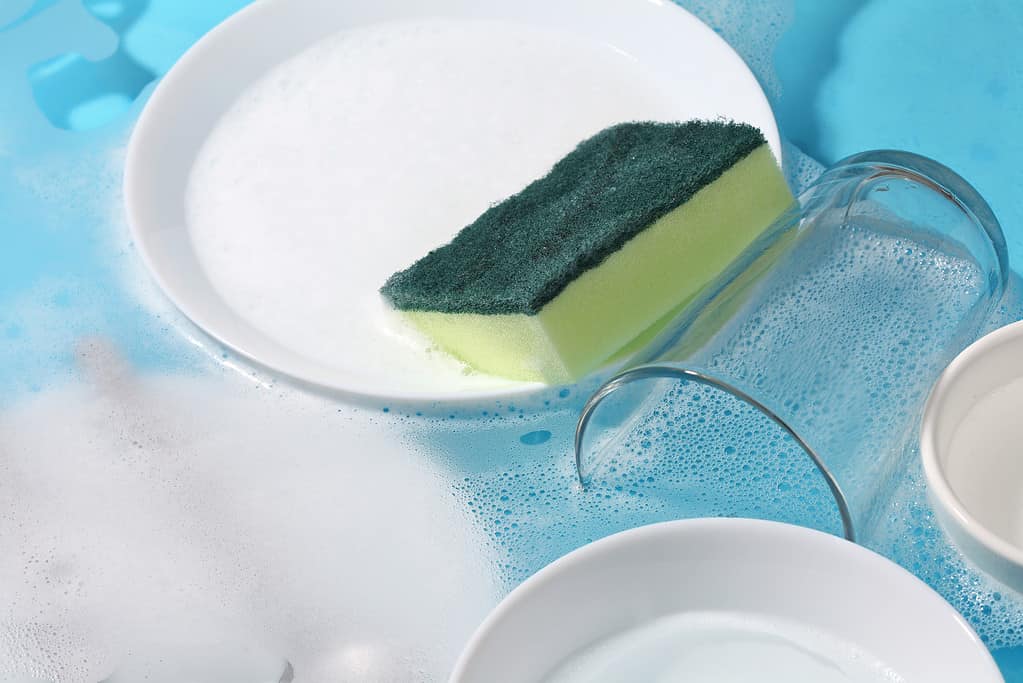
As the bird feeder is exposed to the elements, mold, mildew, and bacteria may grow on them. So, don’t forget to clean it!
©seksanwangjaisuk/iStock via Getty Images
Regularly clean your birdfeeders to prevent the buildup of mold, mildew, and bacteria. Dirty feeders can deter cardinals and pose health risks to all birds. Remove stale food from the feeders and rinse and dry them thoroughly before refilling them with fresh food for the cardinals to enjoy.
6. Use Bird Baths
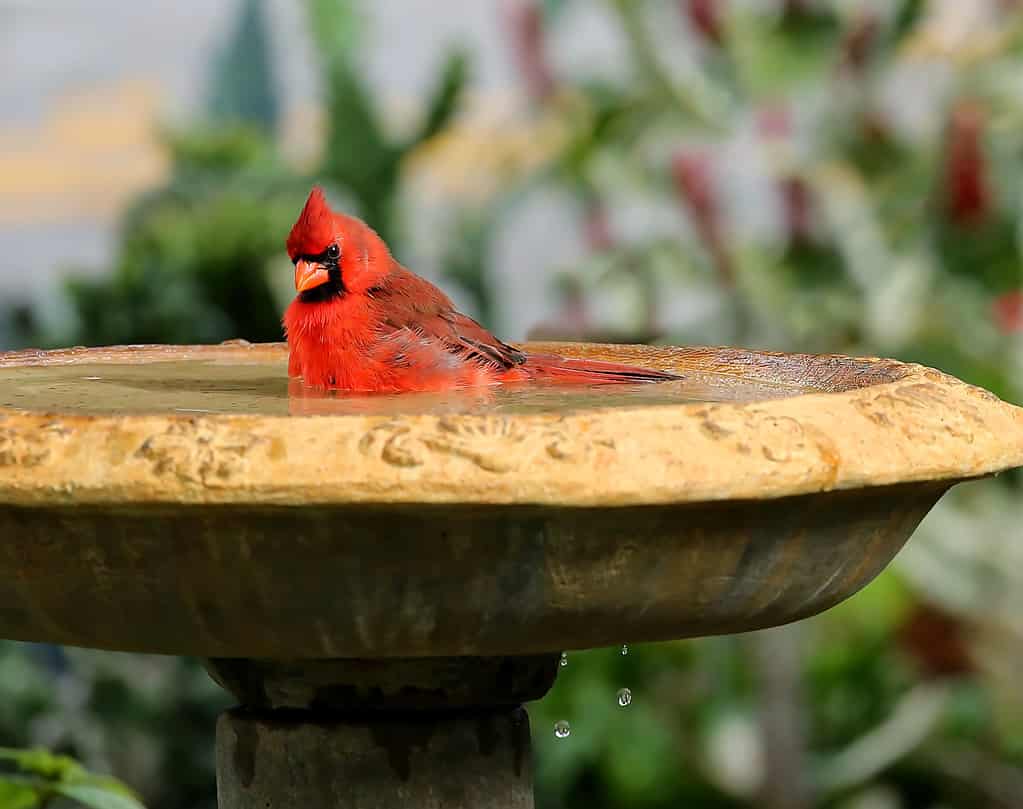
Like most other birds, cardinals love water — both to bathe and to drink.
©JillianCain/iStock via Getty Images
Cardinals love to play and splash with water. Water is not only necessary for these birds to drink, but cardinals need them also to bathe and keep themselves nice and clean. Position the bird bath strategically in your yard near dense shrubs or trees, giving the birds a sense of security. Placing the bath near their favorite feeding area can also increase the chances of attracting cardinals.
Make sure to select a bird bath that is large enough to accommodate cardinals comfortably. The bath should have a shallow basin, as cardinals prefer to wade rather than swim. A depth of 2 to 3 inches at the bath’s deepest would be best. Furthermore, add a stick or two in the water for their security.
7. Keep Clean Water
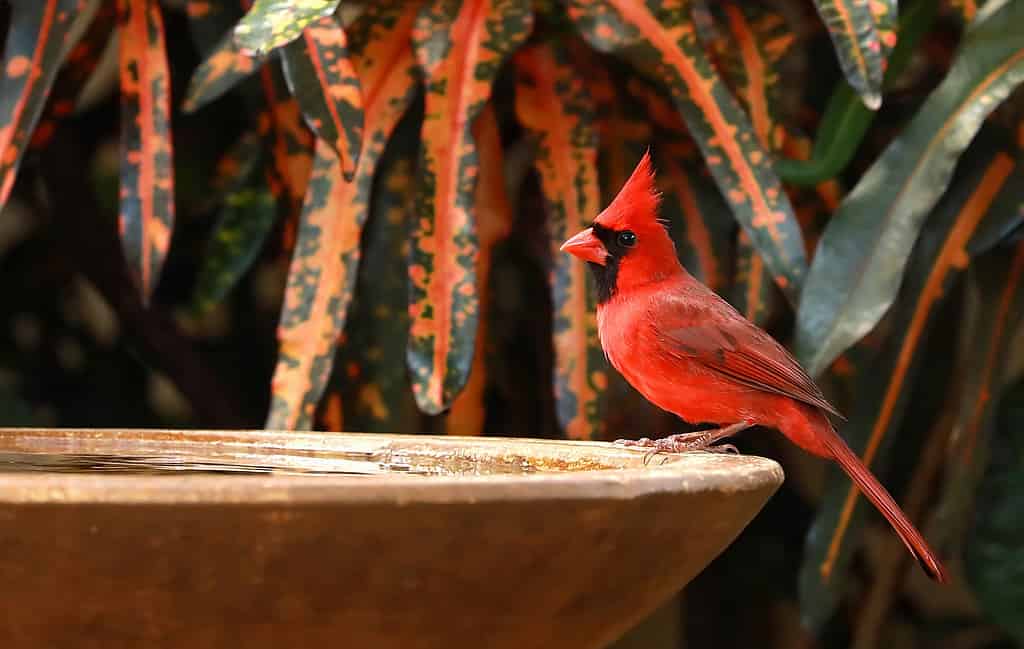
Make sure to clean and change the water in the bird bath to prevent algae and bacteria from forming and taking root.
©JillianCain/iStock via Getty Images
Regularly clean and change the water in the bird bath to prevent the buildup of algae and bacteria. Cardinals, like other birds, prefer clean, fresh water sources.
Also, consider using a heated bird bath during the colder months! You can enhance your bird bath by adding a drip system or a small fountain. The gentle sound of trickling water can be a powerful lure for these birds.
8. Avoid Reflective Objects

Unfortunately, cardinals may sometimes collide with windows or attack their own reflection, damaging their beak.
©Kelly vanDellen/Shutterstock.com
Cardinals can sometimes collide with windows, mistaking reflections for open spaces. Moreover, cardinals are known to attack their own reflections in order to protect their territory. This can be dangerous for the cardinals, as they may damage their beaks.
To prevent these unfortunate accidents, place decals or bird-friendly window films on large windows or glass doors. This will make the glass more visible to the birds and make your place more welcoming and safe.
9. Avoid Pesticides

Instead of using pesticides, opt for natural pesticides, such as companion planting or making a soap or chili spray.
©Worledit/ via Getty Images
Minimize the use of chemical pesticides and herbicides in your yard. These chemicals can harm not only insects but also the cardinals that feed on them. Consider natural alternatives and integrated pest management techniques to keep your yard healthy.
You can go for companion planting as a natural pest management system, as an example. Alternatively, you can also make a soap spray, a chili spray, or diatomaceous earth! For more on this, check out our article on 9 natural pesticides.
10. Keep the Cat Indoors
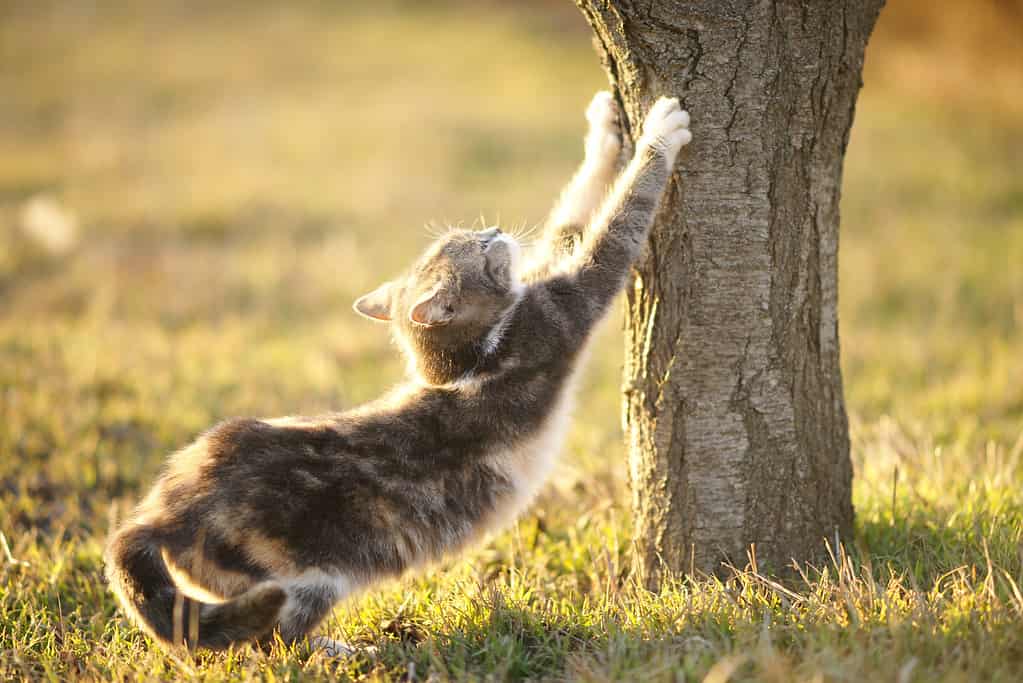
If you have a cat, make sure to keep it indoors, especially during the time of day when cardinals are most active.
©sony_moon/iStock via Getty Images
Maintain a cardinal-friendly space to lure them into your yard. If you have domestic pets, especially cats, take measures to keep them indoors or use cat enclosures to prevent them from hunting birds. Cardinals can unfortunately fall victim to feline predators.
Cardinals are most active during the early morning and late afternoon. During nesting season, it’s essential to keep noise levels down near their nests to avoid disturbing them.
11. Encourage Nesting
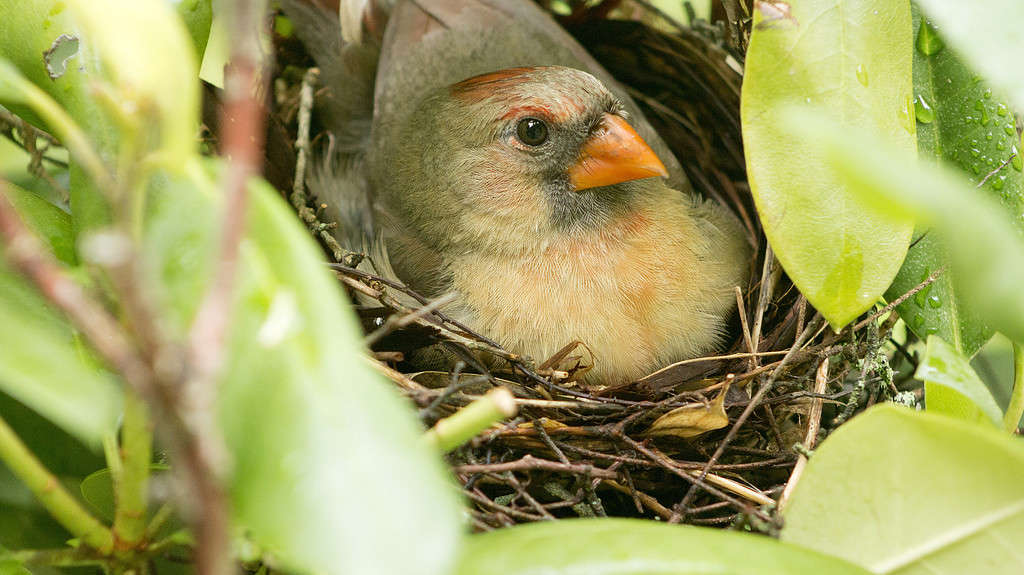
Encourage nesting in your backyard by planting dense plants and providing nesting material.
©WoodysPhotos/iStock via Getty Images
Another way to attract cardinals to your yard is to encourage nesting in and around your backyard. Unlike other backyard birds, cardinals will not gravitate toward birdhouses or nesting boxes, instead preferring to shelter and nest within the dense plants surrounding them. So, one way to encourage nesting is to plant tall trees, thick shrubs, and grape vines – all of which make great nest sites for cardinals.
You should also provide nesting materials to attract cardinals to your yard. While most cardinals will generally use natural plant materials, such as pine needles, twigs, and grass, these birds may also appreciate pet fur and short pieces of string or yarn.
12. Practice Patience
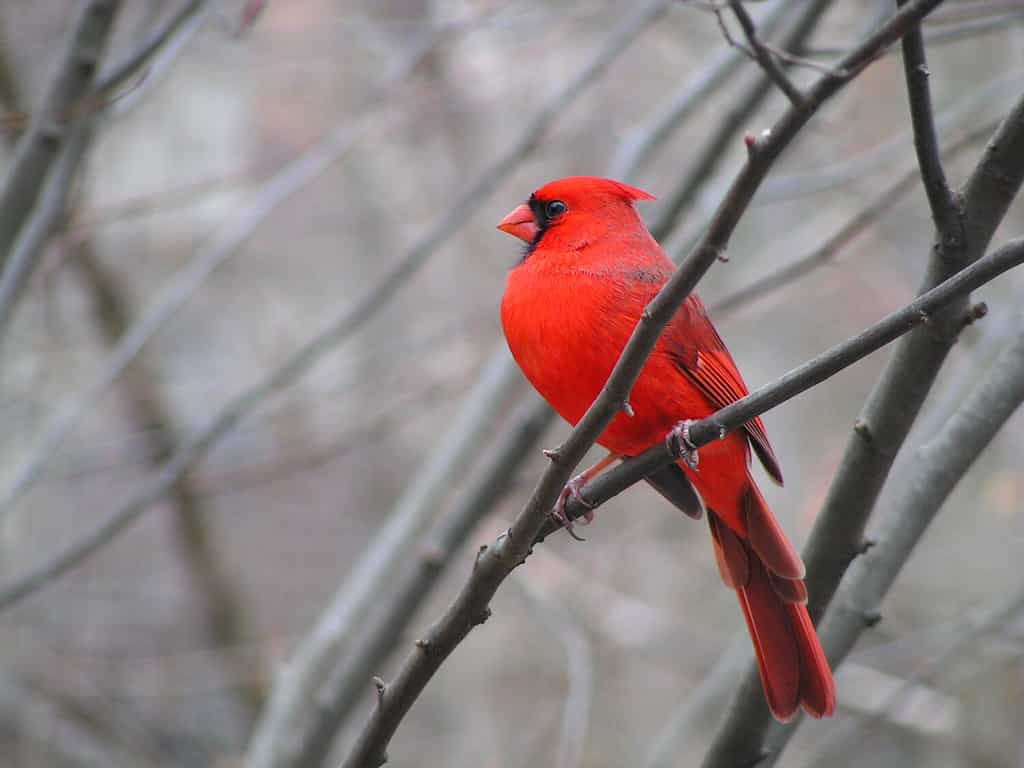
Our final advice: be patient! But as long as you follow the above advice, you should see cardinals in your backyard in no time.
©Mary Terriberry/Shutterstock.com
Attracting cardinals to your yard can be a rewarding experience, but it often requires patience and persistence. These birds are naturally cautious and might take some time to feel comfortable in your garden.
They are more likely to visit your yard if you follow the above methods, so as long as you follow the listed tips, you should have some gorgeous cardinals visiting you in no time!
Summary of 12 Ways to Attract Cardinals to Your Yard
| Number | Way to Attract Cardinals |
|---|---|
| 1. | Provide Thick Habitat |
| 2. | Provide Proper Nutrition |
| 3. | Provide Cardinal-Friendly Feeders |
| 4. | Refill Birdfeeders Promptly |
| 5. | Keep Clean Feeders |
| 6. | Use Bird Baths |
| 7. | Keep Clean Water |
| 8. | Avoid Reflective Objects |
| 9. | Avoid Pesticides |
| 10. | Keep the Cat Indoors |
| 11. | Encourage Nesting |
| 12. | Practice Patience |
The photo featured at the top of this post is © JillianCain/iStock via Getty Images
Thank you for reading! Have some feedback for us? Contact the AZ Animals editorial team.







